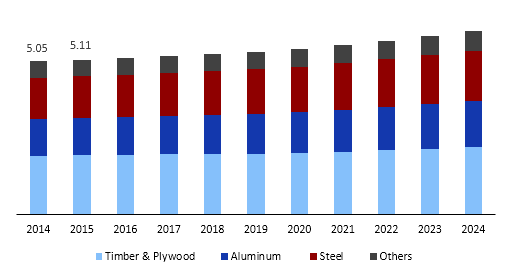
Formwork Market Size and Forecast, By Material Type (Timber & Plywood, Aluminum, Steel) And Trend Analysis, 2014 - 2024
- Published: September, 2018
- Format: Electronic (PDF)
- Number of pages: 69
- Industry: HVAC & Construction
Industry Insights
The global formwork market size was valued at USD 5.17 billion in 2016 driven by a significant emphasis on development of the construction sector owing to its major contribution to the economy. High spending on infrastructure development by various governments is also expected to augment demand for formwork structures in the forthcoming years.
Global formwork market, by material type, 2014 - 2024 (USD Billion)

Formwork structures and its support (falsework) used in construction industry are made of various raw materials, such as timber and plywood, steel, aluminum, and plastic. This structure is an effective approach to reduce overall time and costs required for a construction project.
The global market is anticipated to witness significant expansion on account of minimal considerations, such as simple and reusable mold. The need to provide support to the newly constructed building structures also contributes to the increasing revenue of global market.
Moreover, rising investments by governments aimed at modernizing old infrastructure along with new constructions, both in residential and non-residential sectors will help boost the demand. Increasing saturation of urban population is expected to generate market demand from the residential sector, which in turn, will be a major driving factor.
Segmentation by Material Type
• Timber & Plywood
• Aluminum
• Steel
• Others
Timber and plywood are the most used materials in the formwork market. The segment is expected to account for over 35% of global market share by 2024. The usage of plywood in concrete formwork results in an improved quality of finished concrete. Large sheets of plywood have reduced overall costs of building. Moreover, its smooth surface benefits in the reduction of concrete finishing expenditures. Plywood is an industrial wood that consists of a number of plies or veneer sheets.
However, aluminum formwork structures are increasingly preferred over their counterparts as they are light weight and have low density. Thus, the segment is anticipated to exhibit the fastest growth over the forecast period. Longer life span of aluminum structures proves to be economical as it makes the products reusable for different construction projects. The reusability also makes it an eco-friendly material. As a result of all these factors, the material is anticipated to witness high demand, especially from the developed economies.
Segmentation by Country
• U.S.
• Germany
• U.K.
• India
• China
• Brazil
The formwork market in U.K. was valued at USD 217 million and is expected to reach 252.2 million in 2024. Increased spending on infrastructure development and investments in housing sector are driving the regional market. Housing construction projects are attracting foreign investments, particularly from China. Thus, growth in the housing sector is expected to drive the construction equipment industry, which in turn will augment demand for formworks.
Infrastructure industry has been a backbone of the economic development in India and the growth in this sector can be attributed to the impetus provided by supportive government policies of the country. Infrastructure development includes construction projects of bridges, dams, roads, power and energy, and urban infrastructure. For instance, the Namami Gange project, a special accelerated road development program for North East and the 90 Smart City projects.
Competitive Landscape
Some of the key companies in the global formwork market include PERI GmbH; Doka Group; Brand Energy & Infrastructure Services; ULMA Construction; Acrow; PASCHAL Group; STRABAG SE; NOE Formwork; Mascon; Interfama; Faresin; MFE Formwork Technology Sdn. Bhd.; Wall-Ties & Forms, Inc.; WACO; MEVA Formwork Systems, Inc. and others. Other players include TITAN formwork systems, Farina Formworks, Condor, GETO ALUMINUM FORMWORK CO., LTD and Gifu Kogyo CO., LTD.
Most key companies focus on providing customised solutions according to the need of the construction industry. The solutions and services offered are expected to meet the growing demand for modern infrastructure market.

Choose License Type
- World's largest premium report database
- Transparent pre & post sale customer engagement model
- Unparalleled flexibility in terms of rendering services
- Safe & secure web experience
- 24*5 Research support service
